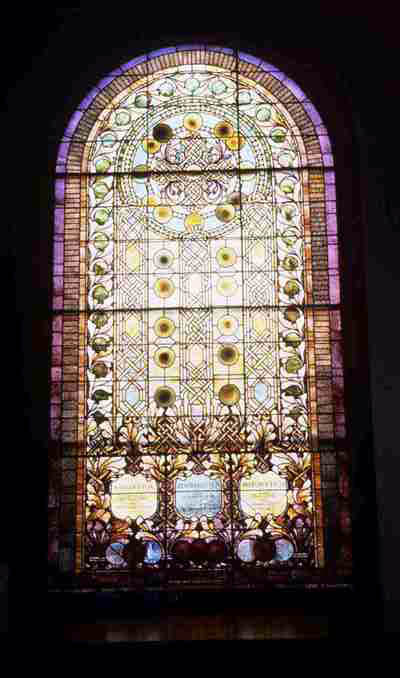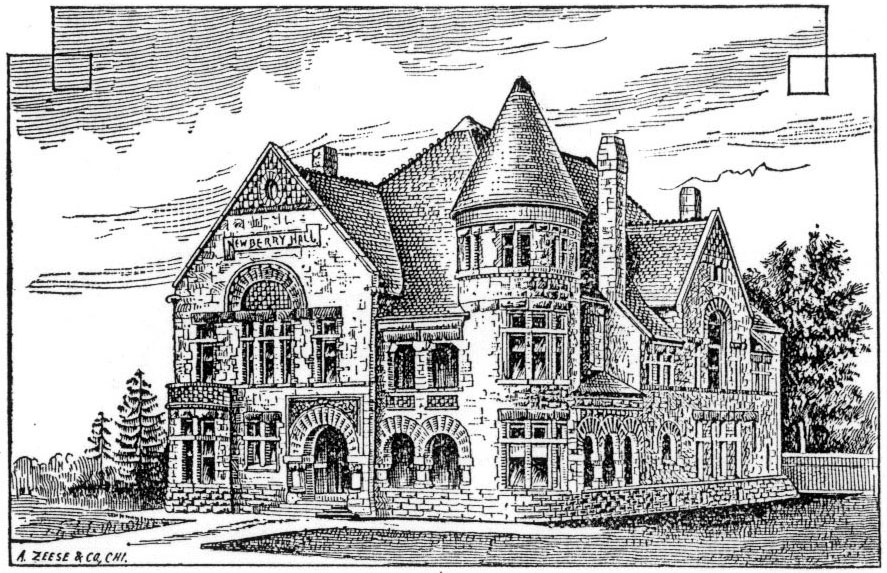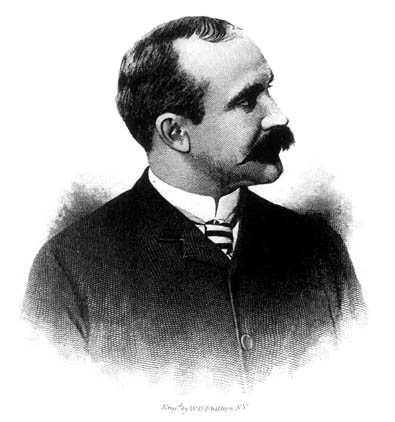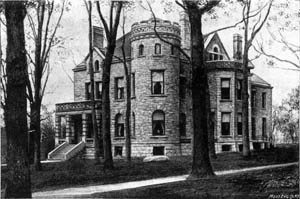

Click here to return to newsletter contents.
 Among
the University's unique and often hidden treasures is a magnificent
stained glass window created by none other than Louis Comfort
Tiffany, one of America's greatest artisans of the Arts and Crafts
period. As many local historians, fans of Newberry Hall, and friends
of the Kelsey Museum know, the window is to be found on the second
floor of the Kelsey Museum building, where it has been hidden
in plain sight for nearly 113 years. The story of how this window
came to be located here involves the happy confluence in the late
nineteenth century of an important student support organization,
its ambitious campaign for a new building, a loyal University
of Michigan family, and a great American artist.
Among
the University's unique and often hidden treasures is a magnificent
stained glass window created by none other than Louis Comfort
Tiffany, one of America's greatest artisans of the Arts and Crafts
period. As many local historians, fans of Newberry Hall, and friends
of the Kelsey Museum know, the window is to be found on the second
floor of the Kelsey Museum building, where it has been hidden
in plain sight for nearly 113 years. The story of how this window
came to be located here involves the happy confluence in the late
nineteenth century of an important student support organization,
its ambitious campaign for a new building, a loyal University
of Michigan family, and a great American artist.
The Students' Christian Association
Newberry Hall was built in 188891 by the Students' Christian
Association (SCA), which had been founded in 1858. This association,
the first of its kind at an American college, based its constitution
on that of the newly formed national organization, the Young Men's
Christian Association (YMCA). In fact the SCA became so closely
associated with the YMCA that both it and its building, Newberry
Hall, were frequently referred to as the YMCA.
An independent organization that catered to University students, the SCA was originally quartered in South Wing of old University Hall, but by its twenty-fifth anniversary in 1883, its membership had grown so large that a campaign was begun for a new building. Looking to the community for donations, especially to its alumni members, the SCA reached out to the Fox family of Grand Rapids, whose long ties to the University and the SCA led them to donate an ornamental memorial window. Why did the Fox family choose to give such an item rather than funds, and why did they commission it from Tiffany? The answers to these questions probably involve a combination of the Foxes' desire to honor family members and the SCA, the surge in popularity of stained glass windows in new buildings devoted to religious functions, and Tiffany's growing reputation.
The Construction of Newberry Hall
In 1883, the SCA's Board of Trustees purchased a lot on State
Street and approved designs submitted by Detroit architect Gordon
Lloyd for a modest one-story building. It was soon clear, however,
that they would need a much larger building, and after requesting
designs from three prominent architectural firms, the board voted
on March 18, 1888, to adopt plans in the Richardsonian Romanesque
style submitted by the noted Detroit firm of Spier & Rohns.
In the earliest known reference to the Tiffany window, they also
voted "that the memorial window be placed in the north side
of the audience room." Thus at this point the board already
knew of the gift of the ornamental memorial window, and it may
even have been ordered from Tiffany soon after the original plans
for a new building were under consideration (in 1883). The architect's
rendering of the building, published locally in The Chronicle
on May 12, 1888, shows the tall, rounded space for the window
already incorporated into the design.
 |
Construction of Newberry Hall began in the spring of 1888, largely financed by a gift of $15,000 from Helen H. Newberry of Detroit. At her request, the building was named in honor of her late husband, John S. Newberry, University of Michigan class of 1847. As built, the first floor of Newberry Hall featured several meeting and prayer rooms, and the second floor was occupied almost entirely by a large audience room or auditorium, with the memorial window gracing the north wall. Originally scheduled for completion in spring 1889, the project was delayed for lack of funds and halted altogether in spring 1890. At this time the building had walls and roof, but little of the interior was complete, although the memorial window was apparently in place. Surviving evidence suggests the window was made in 1888, if not earlier, and installed in 1889. In March 1891 construction recommenced, and Newberry Hall was dedicated on June 21, 1891.
The Fox Family
 |
 |
The memorial window was a gift of brothers E. Crofton Fox (University of Michigan student 1871-73) and Charles Fox (University of Michigan class of 1875) of Grand Rapids, in memory of their father, Reverend Charles Fox (1815-54), and two of their four brothers, William H. Fox (1850-87, University of Michigan class of 1873) and George T. Fox (1848-77, University of Michigan class of 1871).
Reverend Charles Fox had emigrated from England in 1836 and been ordained in the Episcopal Church. He had come to Jackson, Michigan, in 1839. In 1843, he bought a farm on Grosse Ile and built a church there. Due to the need to manage his large farm, Charles Fox took great interest in agricultural matters, becoming editor of The Farmer's Companion and author of The American Text Book of Practical and Scientific Agriculture.
Although continuing to maintain his farm on Grosse Ile, Reverend Fox came to Ann Arbor with his family in 1853. There he gave free lectures in agriculture to University students, farmers, and others in the community while waiting for the legislature to authorize a program in agricultural education at the University. The program was created in 1854, and Reverend Fox was appointed the first Professor of Theoretical and Practical Agriculture at the University of Michigan in June of that year.
Before classes were to begin that fall, Charles Fox returned to Grosse Ile. When their farmhouse was destroyed by fire, the family moved to Detroit, where Charles died from cholera in July 1854, before having formally taught a class at the University. The program in agriculture died with him, as shortly thereafter the legislature decided that agriculture should be taught at a college located closer to the state capitol. In 1871, Mrs. Fox moved her family to Ann Arbor, and her four surviving sons attended the Ann Arbor High School and the University of Michigan.
The family later made its home in Grand Rapids, where Crofton and Charles entered the lumber business. In 1889, they built a new home in the Richardsonian Romanesque style, remarkably similar to the concurrently built Newberry Hall. The style of this home suggests that the Fox brothers were probably influential in the choice of style for the SCA building and of Spier and Rohns as its architects, who very likely also designed the Fox house.
 |
The Tiffany Window
During the years their family was associated with the University,
the Fox brothers must have been active in the SCA, and when the
campaign for a new building began in 1883, Charles and Crofton
sought to honor their father and brothers with the gift of a leaded
stained glass window, designed by Louis Comfort Tiffany (1848-1933)
and executed by the Tiffany Glass Company of New York. The window
is not signed, but-beyond a longstanding oral tradition that it
is a Tiffany window-two important references help confirm its
provenance. An article in the student newspaper of the time, describing
memorial gifts to the building, indicates that "E. Crafton
Fox and Charles Fox of Grand Rapids have contributed a window
designed by the Tiffany Glass Co." (The Chronicle,
May 11, 1889). More importantly, this window is listed in an inventory
of works, A Partial List of Windows, Designed and Executed
by Tiffany Studios, published by Tiffany Studios in 1910.
The listing for Ann Arbor, Michigan, includes: "Y.M.C.A.
Building-Fox memorial window, Ornamental."
The window measures 8' 1" wide by 15' 10" tall and is surrounded by an oak frame. Unlike Tiffany's better-known works, which depicted figures or landscape scenes, the Fox memorial window features an abstract geometric design, common for Tiffany's earliest works. Most of these early pieces were designed by Louis C. Tiffany himself, who, as demand for his windows increased in the 1890s, began to hire other artists to execute the designs.
The Fox memorial window utilizes many kinds of glass, including roundels and chunks or nuggets, as well as plated layers, to produce a range of colors from rich claret and deep sapphire to greens, golds, and lighter shades of pinks, yellows, and blues. The abstract design incorporates not only geometric forms but also floral and vegetable motifs, such as the green pods around the perimeter and the pedal-like forms at the bottom, which embrace the panels naming the honorees. These forms, plus the medallion at the top with its floral images surrounded by roundels, hint at Tiffany's coming mastery of landscape, figural, and ecclesiastical designs.
Louis Comfort Tiffany
Born in New York City, Louis Comfort Tiffany was the son of Charles
L. Tiffany (1812-1902), founder of the famous silver and jewelry
firm Tiffany & Co. Although expected to join his father's
firm, Louis chose to become a painter instead and was apprenticed
to George Inness, a renowned landscape painter. Through extensive
travels, Tiffany became interested in ancient Roman glass, as
well as stained glass in Gothic churches, and was drawn to the
ability of stained glass to marry the skills of artist and handicraftsman
to produce vibrant, expressive works.
Beginning work in stained glass windows in the mid-1870s, Tiffany became an important influence in the Art Nouveau and Arts and Crafts movements in America, in which as much emphasis was placed on the craftsman who created a work as on the artist who designed it. Tiffany filed for a patent in 1880 for his version of opalescent glass techniques. Later he patented a type of iridescent glass that he called "Favrile," from the old English word fabrile meaning "made by hand," and used it widely in vases, lamps, and numerous other objects d'art. At this time, stained and opalescent glass production was surging in America, due in part to a boom in the construction of churches, and Tiffany stepped up to meet the demand for large ornamental windows. Because of his family's wealth and social standing, as well as his father's famous firm, Louis C. Tiffany dominated the world of stained glass production in America.
Louis's firm, founded in 1879, became the Tiffany Glass Company in 1883 and later Tiffany Studios. During his illustrious career Tiffany sought to advance not only the art but also the science of stained glass. He created new kinds of glass and often brought together glass by different craftsmen to achieve the textures and colors he sought. He also used a technique called plating, in which two or more layers are combined to vary the richness and colors. In addition, Tiffany worked to advance the art of leading. After 1900 he made the leading in his windows thinner and often incorporated it as part of the design. Dissatisfied with the heavy reinforcing bars that were required to support the weight of the windows, he worked toward their elimination, and after 1905 the bars were often replaced with narrow steel rods soldered onto the lead lines in the back. Features of the Fox memorial window reflect its creation in Tiffany's early years-the abstract geometric design, the thicker leading, and the heavy reinforcement bars.
Newberry Hall Changes Hands
Commissioned by the generous Fox brothers, created by the legendary
Louis Tiffany, and installed by the SCA in a worthy home, the
memorial window was a remarkable gift for its time. Glorious as
Newberry Hall must have been at its opening, its operation was
a burden to the SCA, which continued to struggle with finances,
even though they built a second larger facility in 1917 to house
their YMCA functions (Lane Hall). In 1920, the SCA decided to
rent Newberry Hall to the University for classes, and in 1928,
it was designated as the site for storage of the University's
archaeological collections. In 1937, the SCA decided to give both
Lane Hall and Newberry Hall to the University, and with this gift
the University acquired the treasure of the Tiffany window. Newberry
Hall became the official repository of the archaeological collections
in 1945, and today the Kelsey Museum of Archaeology continues
to occupy Newberry Hall, where they have been conscientious caretakers
of the Fox memorial window.
Julie Truettner
Preservationist and Building Historian
Copyright © 2002 The Kelsey Museum of Archaeology, University of Michigan. All rights reserved.